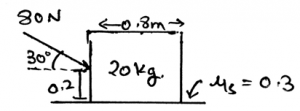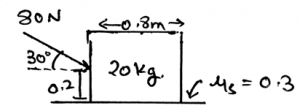This set of Engineering Mechanics Multiple Choice Questions & Answers (MCQs) focuses on “Work – 1”.
1. The principle of work was proposed by________________
a) Mathematician Jean Bernoulli
b) Physios Jean Bernoulli
c) Chemist Jean Bernoulli
d) John Jean Bernoulli
View Answer
Explanation: The concept of work was proposed by Jean Bernoulli. He was a mathematician. It was proposed in 18th century. It gave us various alternative methods to calculate the work done. Thus the answer.
2. Determine the horizontal force acting in the given figure.
a) 80cos30
b) 60cos30
c) 40cos30
d) 8cos30
View Answer
Explanation: The net forces acting on the body is shown with the help of the resultant forces. There are two types, first the frictional and the second is normal. This is because the resultant forces have the sum of all the forces which are acting in the direction which is same.
3. Which of the following is correct?
a) Work done is of one type only
b) Work done is of two type only
c) Work done is of three type only
d) Work done is of infinite type
View Answer
Explanation: The work done is of many types. They are countless. For example, the work can be done by moving, pushing or pulling. Or can be done by car, bus, truck or any other vehicle. This work can be done in many ways.
4. If five forces are acting on the single particle and having an angle of 72˚ between each and are collinear, then_____________
a) The net force acting on the body is zero and the net work done is also zero
b) The net force acting on the body is horizontal
c) The net force acting on the body is vertical but net work done is non-zero
d) The net force acting on the body is at an angle of 45
View Answer
Explanation: The net force acting on the body is zero. This means that the forces cancel out. This means that the body is in equilibrium and doesn’t need any of the external force to make itself in the equilibrium.
5. If solving the question in 3D calculations is difficult, then use the 2D system and then equate the total net force to zero, thus the method for solving the work done.
a) True
b) False
View Answer
Explanation: The answer is obviously yes. If we are having any difficulty in making the vector components, then we can go in 2D. As if the particle is in equilibrium, the net force will be zero. No matter where you see first. Net force is zero.
6. If the body is in equilibrium, but it having a rotational curled ray shown in the free body diagram then:
a) The diagram is wrong
b) Such rotations can’t be shown in the fbds(free body diagrams)
c) The ray shown may be correct, but the body is not said to be in equilibrium
d) The body is said to be in equilibrium only, as the other forces will cancel out that rotation and the network done will be zero
View Answer
Explanation: The body having equilibrium will not rotate at any cost. Yes, the diagram may contain the rotational array showing the couple being acted over the structure. But the thing is that the forces, i.e. the other forces which are outside the dependency of this rotation will cancel out this rotation and thus the body is in equilibrium.
7. If the resolved force or the force which you get as the answer after solving the question is negative, then what does this implies?
a) The force is in the reverse direction w.r.t the direction set in the free body diagram
b) The force is not in the reverse direction w.r.t the direction set in the free body diagram
c) The force component is not possible
d) The force is possible, but in the direction perpendicular to the resultant force
View Answer
Explanation: The negative sign implies things in the opposite manner. If the force is coming negative this doesn’t mean that it is impossible. But it means that the force is in the opposite direction w.r.t the direction set by you in the free body diagram.
8. Determine the vertical force acting in the given figure.
a) 236N
b) 600n
c) 403N
d) 830N
View Answer
Explanation: The net forces acting on the body is shown with the help of the resultant forces. There are two types, first the frictional and the second is normal. This is because the resultant forces have the sum of all the forces which are acting in the direction which is same.
9. What does Newton’s third law states for the work done?
a) The rate of change of momentum is equal to the force applied
b) For every reaction there is an opposite reaction
c) The body is tend to be rotated if the force is applied tangentially
d) The body is rest until a force is applied
View Answer
Explanation: The requirement of the third law is important in the equilibrium of the body. Specially the rigid bodies. The rigid body particles are in the equilibrium and are thus facing the forces and to be in the equilibrium they also react and apply the opposite force and thus the third law of Newton.
10. The net moment of the body is zero that means the work done by the force and the rotational axis is zero.
a) The first part of the statement is false and other part is true
b) The first part of the statement is false and other part is false too
c) The first part of the statement is true and other part is false
d) The first part of the statement is true and other part is true too
View Answer
Explanation: The net moment of the body is zero that doesn’t mean that the work done by the force and the rotational axis is zero. Work done is something different. It does not depend on the rotational axis. It only depends on the distance. And the forces.
11. ∑Fx=0, ∑Fy=0 and ∑Fz=0 are vector equations for the three dimensions. They are satisfied when the body is achieved its state of equilibrium, and then the work done is calculated.
a) True
b) False
View Answer
Explanation: The answer is false as the equations asked are scalars. As we make the net sum of the forces along the axis equal to zero. Of course this equation comes from the solving the vector forms, but still, the result is a scalar, hence the equations are scalar.
12. Which of the following needs to zero for the perfect equilibrium for the calculation of the work?
a) ∑F=0, ∑M=0 and ∑θ = 0
b) ∑F=0, ∑M≠0 and ∑θ = 0
c) ∑F≠0, ∑M=0 and ∑θ = 0
d) ∑F=0, ∑M=0 and ∑θ≠0
View Answer
Explanation: The summation of the forces needs to be zero. So does the summation of the moments need to zero. But talking about the angles, they not needed to zero. But the forces which are acting at particular angles, must needed to be equal to zero. The basic need of the forces to make the body in equilibrium.
13. What is Newton’s second law for work?
a) The rate of change of momentum is equal to the force applied
b) The rate of change of distance is equal to the force applied
c) The rate of change of momentum is equal to the moment applied
d) The rate of change of momentum is equal to the work applied
View Answer
Explanation: The rate of change of momentum is equal to the force applied to the body. This is the second law which is used to calculate the work done in the body by the forces. This has a very vast application on the industrial sector and engineering sector.
14. The supports in the 3D are having more than three reaction forces. Because they are having three axis on which the components of the work done need to be zero.
a) The first part of the statement is false and other part is true
b) The first part of the statement is false and other part is false too
c) The first part of the statement is true and other part is false
d) The first part of the statement is true and other part is true too
View Answer
Explanation: As 3D is defined as the three axis system, we have to consider the equilibrium in all the three axis. This will make the equilibrium go on all the axis of the 3D space. And hence will cancel all the forces.
Sanfoundry Global Education & Learning Series – Engineering Mechanics.
To practice all areas of Engineering Mechanics, here is complete set of 1000+ Multiple Choice Questions and Answers.
If you find a mistake in question / option / answer, kindly take a screenshot and email to [email protected]


